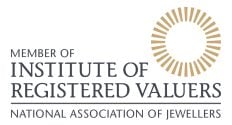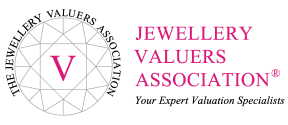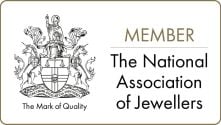11th Wedding Anniversary gift
Turquoise is found amongst the world’s oldest jewellery, seen in items from the tombs of the ancient Egyptians. The ancient Egyptians called Turquoise ‘Mefkat’ which also means ‘joy’ and ‘delight’.
Turquoise is formed in very dry, barren areas. It needs copper rich, acidic water to react with phosphorus and aluminium containing minerals, which produce a porous, mainly opaque (although sometimes semi-translucent) gem material when the water has seeped down through the earth and rocks below.
The colour of turquoise gems can vary from shades of green to a sky-blue. The most sought after turquoise of best colour comes from Iran (formerly Persia). It is sometimes called ‘Robin’s-egg Blue’.
The best quality turquoise is often cut ‘en cabochon’ – flat base with a polished, domed top. Other uses for it would be as flat pieces for sections of inlay or to be turned into beads.
Turquoise can have a lustre (the way a stone looks when light hits it) varying from dull to waxy. Due to the fact that turquoise is formed from an aggregate of microscopic crystals in can alter in its lustre depending on how dense the crystal structure is. fine textured turquoise (having tightly packed crystals) will produce a gem which, when polished has a lovely ‘waxy’ look to it. However, if the material has crystals that are less densely packed, the resulting polished turquoise will have a much coarser texture and a ‘dull’ finish to it.
On Moh’s scale of hardness (resistance to scratching), turquoise is a 5 – 6 so it is a fairly soft gemstone. The more porous examples are also more likely to have a lower toughness compared to those with finer textures.
Due to it’s relative softness, turquoise has been successfully used for carvings, particularly by the Native Americans who often carved fish, birds and animal talismans that were incorporated into jewellery.
Throughout history, turquoise has been treated with oils, fats and wax, with the most effective being whale oil due to its high melting point. Over time though, fats and oils disappear. Wax, although it doesn’t rub off as easily, is still messy and will wear off over a period of time. As these methods of treatment are only temporary, as such, they should be disclosed to any purchaser of these items. One of the reasons for using these treatments it to provide a security layer and help avoid unwanted materials from entering the pores of the turquoise.
Some turquoise is ‘stabilised’, which is when it has been treated with a solution of clear epoxy, liquid plastic or resin which ‘locks in’ the colour and prevents anything getting in or out of the material. It is important to know if the paterial is oil/wax treated or genuinely ‘stabilised’ as some sellers have been known to describe incorrectly.
Enhanced turquoise is material treated chemically to continue what nature hadn’t finished. It is almost undetectable, has an improved colour and lustre and is less porous. However, some pores remain and for this reason only good quality turquoise should be enhanced.
Colour treated turquoise is when it has been injected with coloured dyes into the pores to improve colour and this is often done during stabilisation. It is a practice that should be disclosed to potential buyers as often, cheap, low quality turquoise is made to look a higher quality than it is.
Reconstituted turquoise are small pieces of low quality turquoise that have been ground down into a powder, mixed with dye and a binding agent and it is then made into slabs, which, in turn, are cut to use in jewellery. This type of turquoise is very inexpensive and buyers should be careful as it can be made to look like genuine turquoise.
When manufacturers make turquoise items, they try to use the best, pure blue material, avoiding the host rock (matrix) whenever possible. However, some turquoise with matrix is marketable, particularly if it has thin, delicate ‘web-like’ patterns to it, and this is known as ‘spiderweb’ turquoise and it the second in price to genuine blue turquoise.





